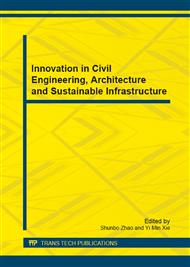p.313
p.317
p.321
p.325
p.329
p.333
p.337
p.341
p.346
Analysis on Axial Stresses of Crossbars on Aqueduct
Abstract:
By use of finite element method, the axial stresses of crossbars on the top of a simply supported rectangular-sectioned aqueduct were calculated in this paper. Three factors were considered, namely height-width ratio, water depth and crossbars spacing. The results show that, most crossbars are in compression when the height-width ratio of aqueduct cross-section is small, and with the height-width ratio increasing, the axial forces of crossbars change from compression to tension; Under a certain height-width ratio, when water depth is relatively small, most crossbars are in compression, and with the increase of water depth, axial forces of crossbars change from compression to tension; big axial tensile force is harmful to the rectangular cross-section floor (mid-span), but favorable to the side wall bottom. The obtained change rules of axial force and the influence of axial force on aqueduct body stress can be referenced to aqueduct design.
Info:
Periodical:
Pages:
329-332
Citation:
Online since:
November 2012
Authors:
Keywords:
Price:
Сopyright:
© 2012 Trans Tech Publications Ltd. All Rights Reserved
Share:
Citation:


